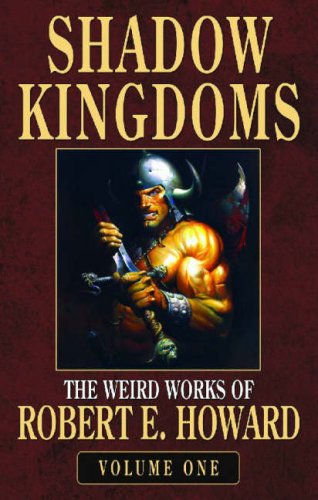
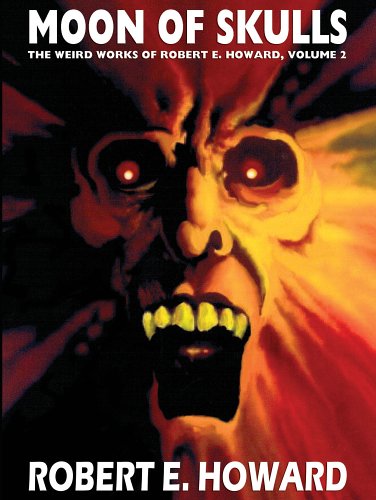
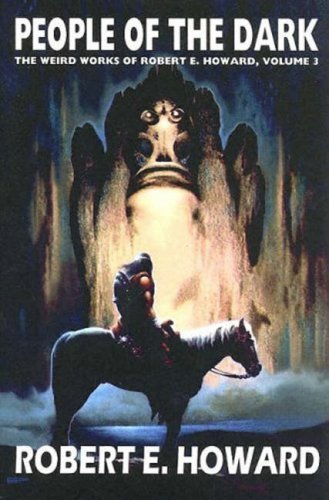
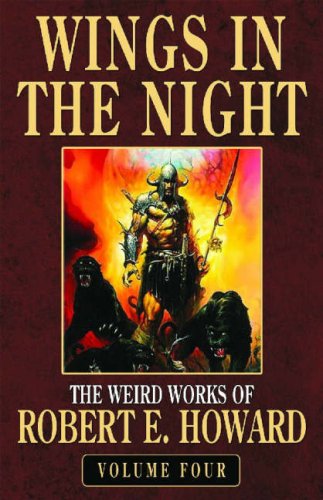

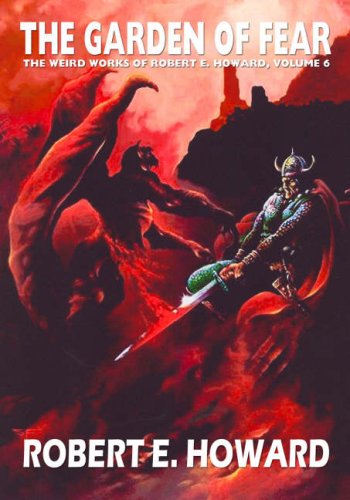
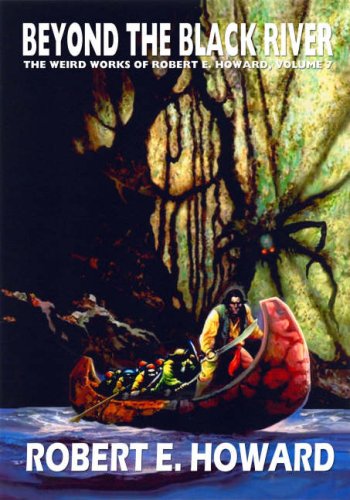

The covers for volumes 1-2 are for the 2006 editions.
Background Colour: -White- -NavajoWhite- -Wheat- -Beige- -AntiqueWhite- -LightGray- -Silver- -BurlyWood- -Tan- -Black- -Blue-
Text Colour: -Black- -Brown- -Blue- -Green- -Red- -Yellow- -White- -Orange- -Silver-
| Vol. 1, Shadow Kingdoms Vol. 2, Moon of Skulls Vol. 3, People of the Dark Vol. 4, Wings in the Night |
Vol. 5, Valley of the Worm Vol. 6, The Garden of Fear Vol. 7, Beyond the Black River Vol. 8, Hours of the Dragon |
|
• Introduction
• Spear and Fang • In the Forest of Villefère • Wolfshead • The Lost Race • The Song of the Bats • The Ride of Falume • The Riders of Babylon • The Dream Snake |
The history of Weird Tales magazine is written not by the editors, but by the authors who appeared in its pages. Of all the celebrated authors that have seen print in “The Unique Magazine” “. . . That Refuses to Die,” the most influential and important writers to call Weird Tales their literary home were the “Three Musketeers:” H.P. Lovecraft, Clark Ashton Smith, and Robert E. Howard.
The youngest of the trio, and also the last one to break into Weird Tales, Howard brought his own strengths to the magazine’s pool of talent. Smith was already gaining popularity as a poet of some renown. Lovecraft’s work, even prior to “The Call of Cthulhu,” wasn’t like anything else being done at the time; imaginative and thought provoking.
Howard was full of clever and interesting ideas, and he was himself an accomplished poet; it would be easy to say that he was a kind of amalgamation of the two authors. However, Howard turned those traits on the axis of something that would become a trademark of his writing: his flair for action. No one could write stirring, visceral action like Howard, whether it was two men fighting a duel of honor or rival armies clashing for glory. His deftly penned prose and poetry made him one of the most popular writers in the magazine.
And it’s no wonder, considering that Howard created his most famous characters and brought them to life for the Weird Tales audience: Solomon Kane, King Kull, Bran Mak Morn, and later, the most famous of them all, Conan the Cimmerian. Howard invented the sword and sorcery tale as we define it with his genre-breaking Solomon Kane, and he continued to refine his idea of a good story—fast action, supernatural goings-on, and compelling characters to hang his plots on—with each new manuscript, each new series.
“You gave me my start in the racket by buying my first story—‘Spear and Fang,’ ” wrote Howard to editor Farnsworth Wright in 1931. “I was eighteen years old at the time.” He sold the story to Wright in 1924, but it didn’t see print until the following year. Howard kept trying to write for other markets, but no one was willing to take a chance on the young, unknown writer from Texas. Wright, however, kept buying Howard’s work, and wrote encouraging things to him. Soon, Howard had three stories scheduled to appear in the magazine—but no money to show for it, as Weird Tales paid on publication, not acceptance.
Howard grudgingly returned to college in nearby Brownwood, seeking a diploma in bookkeeping. While at Howard Payne University, he cranked out several humorous sketches for the college newspaper, The Yellow Jacket. He also wrote numerous poems and the occasional story, many of which were submitted to Weird Tales and other pulps. During the time Howard attended college, his stories and poems were finally appearing in print. Encouraged, he started working on the stories that would later catapult him to the top of Wright’s stable of writers—stories of Solomon Kane and King Kull.
With the publication of “Red Shadows” in 1928, Howard became a literary force to be reckoned with. Who was this Solomon Kane, anyway? A sword-wielding Puritan, fighting pirates and witch doctors in the 17th century? Such a story had never been done before. Horror stories were cheap and plentiful in Weird Tales. Wright reprinted classics from the likes of Poe, in addition to buying new stories from authors writing contemporary horrors. And the historical adventure was certainly nothing new, either. The historical romance was alive and well in the 1920’s, both in classic literature and more modern fare, and even at the movies.
Howard invented sword and sorcery (or if you prefer, heroic fantasy) by combining the two genres. It seems simple and elementary now, but at the time, Howard was stepping out into uncharted territory by taking his love of history (a love shared by Farnsworth Wright) and sprinkling in strange and unexplained events with the intent of having them directly engage the characters. The results were dynamite. Howard had a hit on his hands.
As well liked as the stories were, Wright didn’t publish all of the Solomon Kane yarns that Howard sent him. A capricious editor, he rejected Howard’s offerings as often as he accepted them. Rather than be discouraged by this, Howard took it in stride and reworked the stories and submitted to different pulps. If they came back again, Howard simply changed tactics and wrote about new characters.
Taking the sword and sorcery concept one step further, Howard then created King Kull in the story, “The Shadow Kingdom.” This time, he completely removed any semblance of the world we know and set the tales so far in the past that Atlantis was alive and kicking (and a tribal, barbaric continent, to boot). Kull is himself an Atlantean, and a usurper of the throne of Valusia. With a detailed, if fictitious setting and a strong, savage character, Howard crafted several stories of court intrigue, wizardry, and breathtaking action. Even fewer Kull stories were printed in Weird Tales, but they are a vital link to the Conan stories that followed.
Weird Tales was the mainstay of Howard’s career, a place where he could experiment with new story forms and ideas. Howard frequently crossed genres, and because of the magazine’s loosely defined theme and generous reader comments in every issue, he was able to get a sense of what worked and what didn’t. Many of those readers who commented about Howard’s work were fellow authors, and the ringleader of these Weird Tales writers was H. P. Lovecraft. A recluse living in Providence, Rhode Island, he kept a voluminous correspondence with authors, poets, and fans, and through this correspondence was a tremendous influence on a generation of writers, including Robert E. Howard.
Their correspondence and friendship is legendary. Through the initial fan letter that Lovecraft sent Howard, Howard was able to meet and correspond with Clark Ashton Smith, August Derleth, and other members of what would eventually be known as “The Lovecraft Circle.” They traded poetry and drawings, shared stories with one another, and talked about the craft of writing, when they weren’t arguing politics or recommending books. These isolated authors in other states became Howard’s peers and friends, praising his work and encouraging him to do more of it. They were as influential on Howard as Howard was on them.
The book in your hands is the first of a ten-volume set that collects the fantasy, horror, weird and sword-and-sorcery stories that Howard published in Weird Tales and elsewhere, in the order that they appeared. While not strictly in the order that Howard wrote them, they are valuable in that it gives us a picture of how quickly he improved. Each story builds on the last one, bringing with it whatever worked from the previous endeavor. “Spear and Fang,” for example, is a straightforward action piece. Howard kept the fast action in “In the Forest of Villfère,” changed the historical setting and turned it into a traditional supernatural story. This worked so well that one of the characters in “Villefère” makes a return appearance in “Wolfshead,” a tightly plotted period piece with action aplenty and the first story to net Howard the coveted cover art for that issue. The historical setting would soon reappear in the aforementioned “Red Shadows,” along with a sword-wielding hero, supernatural happenings, and a spectacular fight at the end. With “Red Shadows,” Howard had all of the makings of his signature style in place; a driving plot, memorable characters, brisk action, and poetically rendered prose that leapt off of the page.
Many readers overlook Howard’s poetry and they do so at their own peril. Howard was an excellent poet; he wrote poetry throughout his career, in a variety of styles. Supernatural, macabre, and otherworldly, Howard’s poems all tell fascinating stories. They are especially effective if read aloud. One of the keys to Howard’s effectiveness as a writer was his use of poetical structures in his prose fiction. Repetitive sounds, cadenced rhythms, and succinct word choices are all a part of Howard’s easy-to-recognize, impossible-to-duplicate style.
Even a casual reader will be amazed at how quickly Howard developed as a writer of fiction. You will witness a miraculous transformation as you read these stories, just as the first ever Robert E. Howard fans got to read them. I can just imagine someone reading King Kull for the first time and thinking, “Boy, this is as good as it gets!” and then reading the first Conan story, “The Phoenix on the Sword” three years later. And Howard got better after that. Incredible.
Weird Tales was Howard’s literary home. He felt comfortable enough within its hallowed pages to break new ground and try new things. Howard found colleagues and friends in the other Weird Tales writers who shared his interests and stimulated his creativity. He received encouragement and feedback from Farnsworth Wright, the fans, and his fellow authors. Weird Tales was the anvil on which Howard forged the sword of his literary legacy. These stories are that legacy. Enjoy!
—Mark Finn
July, 2004
Austin, Texas
It goes without saying that Robert E. Howard was a lifelong student of world history. He read extensively on the subject, both fiction and non-fiction, and was familiar with the sweep of mankind and its subsequent rise and fall. In particular, Howard was interested in the decay of civilizations, the backward slide into barbarism. Given his interest in history, Howard’s preoccupation with gothic themes is self-evident. Webster’s New Collegiate Dictionary defines gothic as: “. . . of or relating to a style of fiction characterized by the use of desolate or remote settings and macabre, mysterious, or violent incidents.” That can apply judiciously to most of Howard’s fiction in some way or another; most of his horror and fantasy stories include throwback civilizations, ancient cults, and forgotten secrets of one kind or another. But there is another meaning to the word gothic, and curiously, it is listed before the more familiar definition quoted above: “uncouth, barbarous.”
Also of interest to Howard was “the Orient,” as it used to be called. He read extensively on the subject of Asian history and its people, both for self-education and for entertainment. Asian places and themes figure prominently into Howard’s fiction throughout his writing career.
This brings us neatly to Howard’s first novella, “Skull-Face.” Originally serialized over three issues of Weird Tales magazine, it is the story of an American World War I veteran, Stephen Costigan, and his descent into depravity as a hashish user. Broke, homeless, and at the end of his rope, Costigan is rescued by a mysterious Asian woman who introduces him into a vast criminal organization. Conspiracy piles up on intrigue as Costigan is cured of his addiction and forced to commit crimes for the mysterious leader of the secret society. Eventually, Costigan finds out the truth about his benefactor, but not before he falls for the woman who saved his life.
Told at a breakneck pace, “Skull-Face” is rife with sinister Orientals, stalwart British adventurers, and the requisite amount of fighting and action that was part and parcel of Howard’s signature style. Many have commented on its passing similarity to Sax Rohmer’s “Fu Manchu” series, particularly in the resemblance of the titular Skull-Face himself. In making such a comparison, it would seem that the character was supposed to be a recurring one (Howard started, but never completed, “Taverel Manor,” the return of Skull-Face).
Written sometime in 1928, “Skull Face” wasn’t published until October 1929. “Skull-Face” is a curious story for most Howard fans. It’s a long (over 33,000 words), intricately plotted tale that can’t make up its mind if it wants to be all-action or creeping horror. It seems familiar to fans of serialized fiction characters, but Howard never made good on the implication of a series. Where does “Skull-Face” fit in the larger framework of Howard’s career?
To me, “Skull-Face” was Howard’s first hybrid story. Howard wrote intuitively, feeling his way through a plot or an idea. Many times in his career, he would experiment with a new type of story by writing within a familiar structure, and then adding elements of the new genre he wanted to try out.
In “Skull-Face” we see many pieces of what will show up in later Howard stories. The use of exotic locales was nothing new to Howard’s fiction, and the use of modern London was important because of its rich history going back to ancient times, and was easy for Howard to co-opt for his uses. The fact that Costigan is mostly surrounded by various Asians serves to make them more of a backdrop than a commentary on “the White Man’s Burden.”
Later in Howard’s writing career, he would abandon London’s Chinatown for different Asian cities and locations altogether. Howard would use the ports-of-call in the Asiatic Seas, the Middle East, and other remote locations for his action-packed stories.
Here too we can see the strains of Orientalism as defined by Edward Said in his seminal work on the subject: the notion that the Orient is “Other,” its people lascivious and depraved, and their ideals alien and antagonistic to the rest of civilization. Clearly, Howard is repeating rather than reporting with conviction, since most of the literature and non-fiction at the time is infused with such biases. Howard kept the framing sequence of a racial revolt and co-opted the rhetoric of Rohmer and Kipling to the needs of his story.
The theme of one race or nation rising up to overthrow another is a recurring one in Howard’s fiction. At a time when eugenics was an accepted and prevalent theory throughout the country, Howard often wondered what would happen if, as French author Pierre Louys and most of his history books seemed to think, a dominant country or world power grew so fat and contented that they were susceptible to a takeover from a minority group. This was certainly borne out in Ancient Rome, Egypt, and other places. Why not London? Or Valusia, in the case of the Kull stories, when a clearly inferior outland barbarian seizes the throne? Howard’s Bran Mac Morn stories emphasize the rise of Rome’s power and their extermination of the Picts. These flashpoints of revolt and revolution come up over and over again in Howard’s series and short stories. Whether or not the scenario is successful depended entirely on the point-of-view that Howard wrote the story from.
Also present are the elements of the gothic style; secret passages running, forgotten but not empty, under the streets of ignorant London, are just one little touch. The best example of the gothic is Skull-Face himself. His ancient lineage, his methodology, and his organization are gleefully archaic and strange.
The hero in “Skull-Face” isn’t Costigan, but rather John Gordon, a stalwart British agent cut from the cloth of the Empire. Stiff upper lip, quick to act, and all of the trappings of the kind of characters found in pulp fiction in literal droves. Howard tried several times in his career to write what he considered to be mystery stories, and he claimed that he was no good at it. The truth is, he never wrote any British mystery fiction in the Sherlock Holmes fashion, although “Skull-Face” may be considered such an effort. Actually, Howard was flirting with American hard-boiled fiction, and had he abandoned some of the weird elements and focused on plot complications, he would have been a smash. As it was, Howard tried several times to redo Weird Menace in the Orient stories, in stories like “Black Talons” (see Graveyard Rats and Others) and “Lord of the Dead.” Howard eventually abandoned the British detective and the oriental villain and tried out an American man-of-action, Steve Harrison, a more fitting Howard leading man.
By comparison, Steve Costigan is also a world traveler in the streets of London, and the first-person star of the show, even if he is a passive character. The character name shows up, albeit quite differently, in a series of prizefighting stories written for a different market (see Waterfront Fists: The Complete Fight Stories of Robert E. Howard). Howard also used the name to describe himself in a fictional autobiography, “Post Oaks and Sand Roughs,” which was also written in 1928.
What makes Costigan memorable is the gift he is given from the eponymous villain. “As always the barbarian,” remarks Skull-Face to Steve Costigan, a reference to his general disposition and seemingly inhuman strength (and harkening back to the definition of “gothic”). Costigan appears to be a kind of mutant with his gorilla-like physical prowess (and even makes a brief appearance as an ape), and this is one of the strongest elements that Howard reused for many of his recurring characters: whether they were protagonists or antagonists, Iron Men or Barbarians, successes or failures, Howard was interested in the personalities that were more capable by design or environment than everyone around them. Sometimes they were genetic supermen, and sometimes they were a holdover from a previous age of mankind, but they were always stronger, faster, tougher, and sometimes even smarter and better looking. In the Costigan character, we can see the beginnings of what will later become Howard’s most compelling characters. “Skull-Face,” then, is a plateau and possibly a gateway to the rest of Howard’s fiction career.
The rest of the stories and poems in this volume are no less engaging, as Howard’s skills as a wordsmith were improving with each story. “The Fearsome Touch of Death,” a strange little study in fear, is one of the most unknown Howard stories of all, and this marks its first appearance in book form since it debuted in Weird Tales in February, 1930.
“The Moon of Skulls,” another Solomon Kane story, sends the Puritan avenger to Africa to rescue a woman from a vampiric, decadent civilization (sound familiar?). The next Solomon Kane story, “Hills of the Dead,” puts a fresh spin on the tired old zombie as Howard methodically worked his way through the monster canon of Weird Tales cliches. We saw ghosts and werewolves in Volume 1. In Volume 2, we get vampires and zombies and mummies (after all, the villain in Skull-Face is a mummy returned to life).
“The Voice of El-Lil” rounds out the fiction in this book. Again we see world travelers, British men-of-action, and a tale of one of their adventures gone horribly wrong. This gothic oriental story precedes “Skull-Face” and these characters will re-emerge in an altered form later on in Howard’s El Borak tales. For now, they do a credible job of conveying atmosphere and suspense.
You may again be tempted to skip the poetry that is scattered throughout the book. Fair warning: if you do, you’ll miss some of Howard’s best, most interesting work. Sure, it’s short, and it’s poetical, but trust me, Howard was a master at packing thought and emotion into a very short space. At the very least, you must read “Dead Man’s Hate.” It’s one of the great Howard poems, and one of my favorites as well. Howard reveals much about himself in his poetry.
The period between 1929 and 1931 was a busy time for Robert E. Howard. He was writing quickly and often, and while humorous boxing fiction made up a lot of his income at the time, he was busy exploring his darker thoughts, his more pessimistic impulses, and trying them out for other markets. He never really stopped writing weird tales for Weird Tales. He was clearly searching for something, and each completed story brought him closer to the fictional answer he sought. These stories show the beginning of Howard’s steps toward literary immortality. Enjoy!
—Mark Finn
October 2004
Austin, Texas
It’s easy for me to relate to Robert E. Howard. At least in many ways. Because I too grew up in a small Texas town, East instead of West, and in that respect, less bleak, but still, a small town. A town populated by good, solid people, but a small corner of the earth cursed with a kind of raw wound of ignorance, a black hole void of the possibilities of a bigger universe.
In spite of all the bad things said about television, it must be said that it brought to the small back waters of civilization a broader view of the world and opinions and beliefs other than those held by the residents of those stagnant back waters.
But in Howard’s time there was more darkness than light, and without interference, these wounds were left to fester in a cultural vacuum that must have sucked the very air out of Howard’s lungs.
At least it felt that way if you were born with a creative fire in your belly, a razor-eye, a vision that looked not only at what it saw, but around corners, and saw backwards into the past and dressed it up in a manner that fit no past at all, except that which existed in the head, and was, as all spirited imagineers will tell you, far more real than any past that had been or any future that might be.
I suspect that this kind of thinking is not subject only to Texas, but to any area where culture is thought to be a ornament, or something sissy, and that in such places a fist fight is of more importance than a poem. But whatever the case, Howard’s cross to bear, his hole in the world, was a bleak little spot of West Texas dirt that to this day is little more than a hole in the road with a Dairy Queen, a library, and finally, his home, now a museum dedicated to the imaginings of its most prominent and well known citizen, who during his life time was thought, at best, eccentric, and at the extreme, just plain old nuts.
I discovered Howard in 1970. It was my first marriage, and my first year of college. I was going to Tyler Junior College, wanting to write, wondering if it would ever happen, and not thinking my wife understood this at all.
Or maybe I understood her not at all.
But the point was this. I was feeling high and dry and lonely and bleak as Howard must have felt when he sat down to type many of his stories. And during the time this feeling was on me, hanging around my shoulders like some heavy poison-laced cloak, I found a paperback called Wolfshead. It was a collection of stories, and the first thing that struck me was the introduction (and if the introduction was, in fact, part of some other Howard book, don’t tell me, let me have my lie of memory). In this introduction he talked about the fact that he had made his living from his wits, from work of his own choosing, and he didn’t have some sonofabitch standing over him, telling him what to do.
As a young man who had worked every odd job imaginable so that I could go to college and not end up a permanent ditch digger, or aluminum chair factory worker, or field worker, or handyman who was not so handy, this struck a chord.
Deep down inside of me a string throbbed, and there was a kind of high note hit, and I felt a sudden kinship to this man. I knew of what he spoke.
Then there was the fiction. It was on fire, and full of sparks and smoke, lightning and thunder, primary colors cranked up bright.
I hadn’t had this much pure fun as a reader since Edgar Rice Burroughs kicked my ass as a kid.
This man was pulpy and raw and powerful, and it was obvious that, like Burroughs, he believed in what he wrote. In the next couple of years, I discovered Conan, which I still believe to be his best work, and many other stories by Howard, but the thing that sticks with me, Conan aside, are the non-series stories. The ones that thrilled me and made my skin crawl, and yet somehow tied me to the Texas world I grew up in. Because no matter how wild the story, how bizarre the idea, or what location he claimed for it, I assure you, Howard was always writing about Texas and Texans.
These stories are full of Howard’s piss and vinegar, Howard’s heart and soul.
This collection contains many fine tales. One of my favorites is “The Horror from the Mound.” I’ve read it many times, but when I first read “The Horror from the Mound,” I was certain I had never read a horror story quite like it. It wasn’t the usual tale of a monster and a hapless protagonist, but that of a Western hero confronted with a problem, and like all true Western heroes, he had to just go out and do what he had to do, which was face off with the thing and try to defeat it.
Self-reliance.
Courage.
Confidence.
These are all hallmarks of Howard’s fiction, and of Texans, and they are its main appeal. It’s especially powerful to readers below the age of twenty-five, because from adolescence to the mid-twenties, we may feign these feelings, but if we are truthful, it is hard for us to embrace them with the fullness we would like. Therefore, we experience them through others, or through the beautiful lies of fiction.
It’s good to have heroes.
Or at least heroics. Howard’s characters were not always heroes. Not in the classic sense. Conan was really quite a turd, if you think about it. But, somehow Howard was able to give him such a sheen of power and verisimilitude and energy that, on some level, we all wished to be him.
I know that his introduction, his words, eventually led me to drop out of college and write. Just go for it. Because, I too, like Howard, did not want to end up with some sonofabitch standing over me telling me what to do, and also like Howard, I wanted to make my own way by my wits, doing work of my choosing.
I thank his shade for that.
And readers should thank his shade for all the work that exists. Including the fine hot-pulp stories in this volume. And maybe, just maybe, we should be angry with that same shade for taking himself from us so soon. Killed not, in my view, by his inability to accept his mother’s expected death, but, by a series of events.
The loss of a woman he really cared about, Novalyne Price, someone who was an intellectual stimulant, as well as possibly his one true love. Add to this, the soon to be loss of his mother, who never judged him and always encouraged him, and finally add in this certain knowledge: Now he would be sitting alone dangling his feet over the rim of a lonesome abyss.
If he had had the courage to stand up to that, how much more of his fiction would we have seen?
How much greater would his mind have developed, and how much greater would his writer skills have become in time?
As it were, trapped in a sort of permanent adolescence, fueled primarily by his own energies, intelligence, and creativity, he gave us much. And even now, long gone, the echo of his voice, and ultimately of the .38 he used to take his life, resound forever.
Read these stories and enjoy. Dip into the exciting horrors and adventures of Robert E. Howard.
Do not come to them with an academic mind.
Come to them with an eager heart. That way they will give you much. Because they know little of logic, and much of desire—and desire drives us.
Howard knew that. Let him share this knowledge with you.
And finally, if you’re someone sitting in some bleak place with nothing but the hungry sounds of the inner gnawings of creative desire chewing at your head, here is something to feed the beast within until you too can rise up Phoenix-like and leave it all behind in your wing-flapping wake, minus the suicidal gun fire, of course.
—Joe R. Lansdale
How does one justify violence? Robert E. Howard (“REH”), as an author, almost always preferred to create stories based on physical conflict. And as REH wanted to constantly expand his skills and improve his workmanship, REH faced the challenge of utilizing new and different reasons for the violence and strife he preferred in his works. By the year 1932, REH had already used boxing, the fall of civilizations, treachery, survival and even Lovecraftian horror. But now he would come up with a reason that he could turn into a great set of stories: Revenge! Revenge works well for the short story format, as the situation is quickly created, the evil deed done, and the revenge unleashed, strongly justified, to the hero if not to the reader. First used so skillfully in the incredible “The Dark Man,” REH in short order turned out a focused number of new gems, each of which regularly make fans’ Top 20 lists of REH stories. These include “Wings in the Night,” “Worms of the Earth,” “The Scarlet Citadel,” and “The Tower of the Elephant,” all of which are presented in this volume.
“Wings in the Night” may be REH’s ultimate presentation of the failed and now angry and avenging angel story. REH’s religious hero, Solomon Kane, goes clean berserk, and finds a way to destroy an entire race, in what is arguably the best of the Solomon Kane stories. “Worms of the Earth” sees REH moving away from the simplicity of the hero being the executioner, and instead making the hero become the catalyst to set the revenge in motion. In “Worms of the Earth,” Pictish king Bran Mak Morn unleashes unspeakable evil to kill a single man, a Roman leader. Then in “The Scarlet Citadel” and “The Tower of the Elephant,” REH’s greatest hero, Conan, is the unwitting catalyst for the revenge of others, though of course it works out to his benefit as well.
REH would wind his way through other justifications for violence as his skills evolved, though revenge would remain a touchstone he would return to again and again, including in several of his Crusader and El Borak stories.
The other two stories in this volume show some other story types REH was working on. “The Cairn on the Headland” is almost contrary to revenge, as the man who hates so much, and wants to kill, in the end tries to save, his love of humanity rising in the face of supernatural risk. It makes for an interesting counterpoint to “Worms of the Earth,” in which the hero recognizes the risks that will be unleashed, and does it anyway. What it says about REH’s fans, that “Worms of the Earth” is sometimes considered the best REH story ever, and “Cairn” is not among the Top 20, would be an interesting bit of analysis.
“Phoenix on the Sword” is the historically important first Conan story. While it started life as a rewrite of an unsold Kull story, “Phoenix” establishes the very unique character of Conan, and sets in place the history and many of the attributes of the Hyborian Age, from which all the later stories would flow. Conan would consume REH for a couple years, with REH generating an enormous volume of work based on the character.
This volume also contains the last of REH’s poetry that would be published in Weird Tales during his lifetime. REH quit sending poetry to Weird Tales, as he was paid by the word, and he quickly found out that a simple 16 line poem doesn’t pay nearly as well as a 10,000 word story, especially when the editor will only include one work per author per issue.
All stories and poetry in this volume have been restored to the first published version. So you will get to read them just as the pulp readers of the 1930s did. It is hoped you will find them as exciting, fascinating, and emotionally gripping as they and innumerable later fans have found them to be.
—Paul Herman
July 2005
|
• Introduction
• Black Colossus • The Man on the Ground • The Slithering Shadow |
• The Pool of the Black One
• Old Garfield’s Heart • One Who Comes at Eventide • To A Woman |
• Rogues in the House
• The Valley of the Worm • Gods of the North • Shadows in the Moonlight |
by James Reasoner
|
• Introduction
• Queen of the Black Coast • The Haunter of the Ring |
• The Garden of Fear
• The Devil in Iron • The Voices Waken Memory |
• The People of the Black Circle
• A Witch Shall Be Born |
by Benjamin Szumskyj
|
• Introduction
• The Grisly Horror |
• Jewels of Gwahlur
• Beyond the Black River |
• The Challenge from Beyond
• Shadows in Zamboula |
by Damon C. Sasser
|
• Introduction
|
• The Hour of the Dragon
|
• The Hyborian Age
|
by Paul Herman